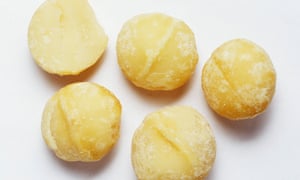ORIGINAL ARTICLE : https://www.theguardian.com/science/2019/jun/01/nut-of-note-70-of-worlds-macadamia-come-from-single-australian-tree
New research shows a single 19th century tree in southern Queensland gave rise to the world’s dominant plant variety

The small Queensland town of Gympie has been identified as the origin of 70% of the world’s macadamia nuts.
New research into the fatty seed has revealed the world’s dominant commercial cultivar – grown in Hawaii – originated from a single tree in southern Queensland from the 19th century.
Native to Australia, macadamia trees are only found naturally in southern Queensland and northern New South Wales. The Hawaiian macadamia industry was grown from one cultivar from Australia that was repeatedly cloned.
This means the commercial macadamia tree has an incredibly low genetic diversity, and researchers hope their findings will spur the discovery of wild trees and more “novel genes”.
Genetic diversity would improve crop productivity, increase disease resistance and enable macadamia to be grown in new places, said one of the researchers, Dr Craig Hardner.
By looking at genetic markers, Hardner, from the University of Queensland, and Dr Catherine Nock, from Southern Cross University, traced the origins of Hawaii’s whole industry back to Queensland.
The Hawaiian cultivar had distinctive gene markers in common with a tiny crop of trees in the small locality of Mooloo, near Gympie, 160km north of the state capital Brisbane. Historical records showed that seeds from these trees were taken to Honolulu in 1896.
Despite being found in a narrow band of subtropical rainforest, Australia’s native macadamia had a rich diversity compared with the commercial crops, Hardner said.
This means there is hope for diverse genes to be discovered in Australian forests and even in backyards.
“There is a really strong geographic pattern,” he said. “All the diversity that exists comes from south-east Queensland and northern NSW. Certainly the Hawaiian germplasm is very narrow, so it has only come from one locality.”
The researchers found that some unique genetic markers in commercial trees could not be matched with known wild trees.
Hardner said this meant either those diverse genes had been lost in the wild, through land clearing, or that they continued to exist in domestic cultivated plants.
“We suggested maybe some of that diversity that has been lost is in cultivated plants, parks, gardens or people’s backyards,” he said.
The oldest known cultivated macadamia tree is in Brisbane’s city botanic gardens, first planted in 1858.
Hardner said the next step was to focus on forest conservation.
“There’s climate change happening, there is clearing happening, and about 90% of the wild population is on private property,” he said. “It’s really important to identify where there are unique genes in the wild and prioritise those populations for conservation.
“Macadamias are only a few generations from the wild. They have not gone through as many cycles of selection as, for example, apples. This means there is still a lot of opportunity to improve them.”
Macadamias are a major export crop for Australia. In 2017, they made up 14% of the value of all horticultural exports